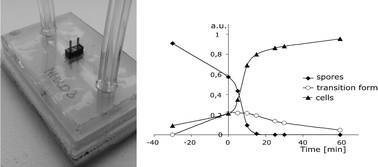A microfluidic device for real-time monitoring of Bacillus subtilis bacterial spores during germination based on non-specific physicochemical interactions on the nanoscale level†
Abstract
A microfluidic device for studies on the germination of bacterial spores (e.g. Bacillus subtilis) based on non-specific interactions on the nanoscale is presented. A decrease in the population of spores during germination followed by the appearance of transition forms and an increase in the number of vegetative cells can be registered directly and simultaneously by using the microfluidic device, which is equipped with a conductive polymer layer (polyaniline) in the form of a nano-network. The lab-on-a-chip-type device, operating in a continuous flow regime, allows monitoring of germination of bacterial spores and analysis of the process in detail. The procedure is fast and accurate enough for quantitative real-time monitoring of the main steps of germination, including final transformation of the spores into vegetative cells. All of this is done without the use of biomarkers or any bio-specific materials, such as enzymes, antibodies and aptamers, and is simply based on an analysis of physicochemical interactions on the nanoscale level.


 Please wait while we load your content...
Please wait while we load your content...